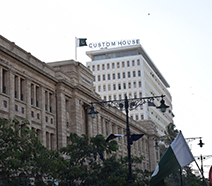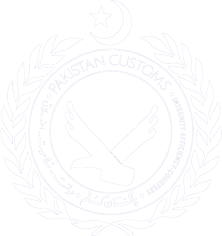History of Customs Collectorates
In 1916 a mutual fund was created by the Secretary Preventive Service Club to commence the construction work of Preventive Service Club at Keamari.
This club and the funds were being handled by the elected Secretary of the Preventive Service Club in consultation with the executive body of the Club and its members.
During early 80’s a new piece of land measuring 11.4 Acres was purchased from the Government of Sindh, for building Preventive Service Club and Sports Complex.
All the payments for the purchase of land and its development were paid from the Preventive Service Club funds.
It was proposed that in order to run the newly bought piece of land funds shall be required and therefore, all the good which were seized by Preventive Enforcement Staff and ultimately disposed or sold to NLC or Utility Stores Corporation should be charged with levy and the amount so recovered shall be deposited in a separate account titled Welfare Fund Preventive.
This amount was exclusively gathered and deposited in the Preventive Welfare Fund, There was no other source of fund from anywhere or any contribution from anyone as it was exclusively done by the Preventive Staff and not even the PA, AO and Eos working in Preventive Collectorate at that time.
This levy was lateron challenged by the buyers with the Federal Ombudsman, who ordered for its stoppage. By that time and amount of 10 Million was available in the accounts. Since its inception a Retd SPS was the Secretary of the Welfare Fund. CPF was a separate entity which was created in Custom House and the source of funds was from the reward money share of CPF, who had its own Secretary. The amount of 10 Million available with the Welfare Fund was invested in DSC which ripes in the year 2002-3 and an amount of 43 Million was received after encashment of DSC. This amount was again re-invested with commercial banks and it grew manyfolds.
Historical & Legislative Background
The origin of an organized Customs Department in the Indo-Pak Sub-Continent can be traced to 1878 when maritime Customs operations were sought to be institutionalized by Her Majesty’s Crown under the Sea Customs Act.
In 1901, Karachi was declared as the Chief Port of Sindh. In the following year, a plan was instituted to build permanent offices for the port and Customs officials at Karachi. The task was entrusted to Mr. G. Willet, the consulting architect to the Government of Bombay, who designed the new building as a semi-circular structure in the Victorian tradition. The construction of the building commenced in 1912 and culminated in 1914. The first meeting of KPT and Customs was held in that building on 12 January 1916.
After independence in 1947, the Sea Customs Act, 1878 continued to be the legal framework for Customs operations in Pakistan. However, the need for a new Customs legislation was felt all along. The task of developing the new legislation was undertaken by Mr. G. A. Jehangir in 1966, who in his capacity as the First Secretary of the Central Board of Revenue, worked on the project for three years. It was by dint of his hard work and professional acumen that the Customs Act, 1969 was promulgated on 20 June, 1968.
Evolution of Customs Collectorates
For many years following the promulgation of the new Customs Act, the Customs operations were carried out in the country in three, and subsequently two geographical zones.
In the southern part of the country, the central Customs organization was the Preventive Collectorate, based in Custom House, Karachi. It was responsible for controlling all international cargo and passenger operations. As domestic commerce grew and the size of national economy increased, the import operations were entrusted to another organization called the Appraisement Collectorate, which was established on 3 October, 1976 in Karachi. This was followed a decade and a half by the creation of the Exports Collectorate on 24 October, 1990 in Karachi.
As a result of the establishment of new Collectorates in Karachi, and the growing paucity of space in the Custom House, it was decided that a new bigger building will be built adjacent to the old one. For this purpose, 2,30,260 sq. ft. of land was procured from the Karachi Port Trust in 1978. The foundation stone of the new Custom House was laid by the President of Pakistan, Gen. Muhammad Zia ul Haq on 7 March 1979. It took eight years to construct the new Custom House, which was inaugurated by the Prime Minister of Pakistan, Mr. Muhammad Khan Junejo on 8 May 1987. The new Custom House has twelve floors and is built on an area of 1,60,140 sq. ft.
The Custom House Karachi is the headquarters of Preventive Collectorate, Appraisement Collectorate and Exports Collectorate, in addition to Model Customs Collectorate at present.
In the southern region also, the Collectorate of Customs, Central Excise and Sales Tax, Hyderabad was established in 1967 subsequent to the bifurcation of the Collectorate of Central Excise, Karachi. The jurisdiction of Hyderabad Customs Collectorate comprises the whole of Sindh, excluding Karachi, Multan and Bahawalpur.
The Collectorate of Customs, Quetta was carved out of the Hyderabad Collectorate in May 1977. It controls the whole of Baluchistan, including Hub and Gaddani. As maritime imports and exports grew, another seaport called Port Qasim was established forty five kilometers outside Karachi. The Collectorate of Customs, Port Qasim, was accordingly set up in August 1993.
As part of the modernization drive, a Model Customs Collectorate was set up in Karachi in 2004, which now administers cargo clearance operations at various sea-ports and terminals in Karachi through its web based system called PACCS (Pakistan Automated Customs Clearance System).
In the northern zone, Customs and Central Excise operations were carried out simultaneously through the Collectorate of Central Excise and Land Customs Lahore. It was the second oldest Collectorate in the country whose jurisdiction spanned the whole of the former West Pakistan, barring Karachi and Baluchistan. Custom House Lahore was the regional Customs and Central Excise headquarters.
With the passage of time, it became desirable to set up additional Collectorates in the northern zone to cater to the ever-increasing requirements of Customs and commercial operations.
As a result, the Peshawar Collectorate was established on 1st July 1974. Its jurisdiction extended to the whole of NWFP and there districts of Punjab, namely Rawalpindi, Attock and Jhelum. This jurisdiction remained unchanged till 1st July 1981 when the Collectorate was bifurcated into Peshawar and Rawalpindi Collectorates. The jurisdiction of the Peshawar Collectorate comprises the whole of the NWFP, while the Rawalpindi Collectorate controls the territory from Jhelum river upto the Northern Areas.
In 1994, the Collectorate of Customs Lahore was further divided into Lahore and Gujranwala Customs. At present, Collectorate of Customs, Lahore controls ares in the administrative division of Lahore only.
The Collectorate of Customs, Central Excise and Sales Tax, Multan was established in April 1990. Its jurisdiction comprises the civil divisions of Sargodha, Faisalabad, D.G.Khan, Bahawalpur and Multan (excluding districts of Sahiwal and Pakpatan).
The last Collectorate set up in the northern region was in Faisalabad, which became operational in May 1998.
Pakistan Customs Vision, Mission & Values
Like any other Government agency, Pakistan Customs has its unique vision, mission and values, which are appropriate to its role and importance.
Our Vision
To be a modern, progressive, effective and credible organization for optimizing revenue by providing quality service and promoting compliance.
Our Mission
Enhance the capability of the tax system to collect taxes through application of modern techniques, providing tax payer assistance and by creating a motivated, dedicated and satisfied, professional work force.
Our Values
Integrity – Professionalism – Teamwork – Courtesy – Fairness – Transparency – Responsiveness.
In Sync With Present & Future
Today, Pakistan Customs is major player in national economic growth by virtue of its commitment to provide a fiscal and procedural environment, which underpins and sustains enhanced trade in the country, and facilitates flow of goods across national borders. It is equally committed to protecting the national polity against the threats which need to be countered in that process. In so doing, it is striving to achieve the highest standards of professional service and excellence.



